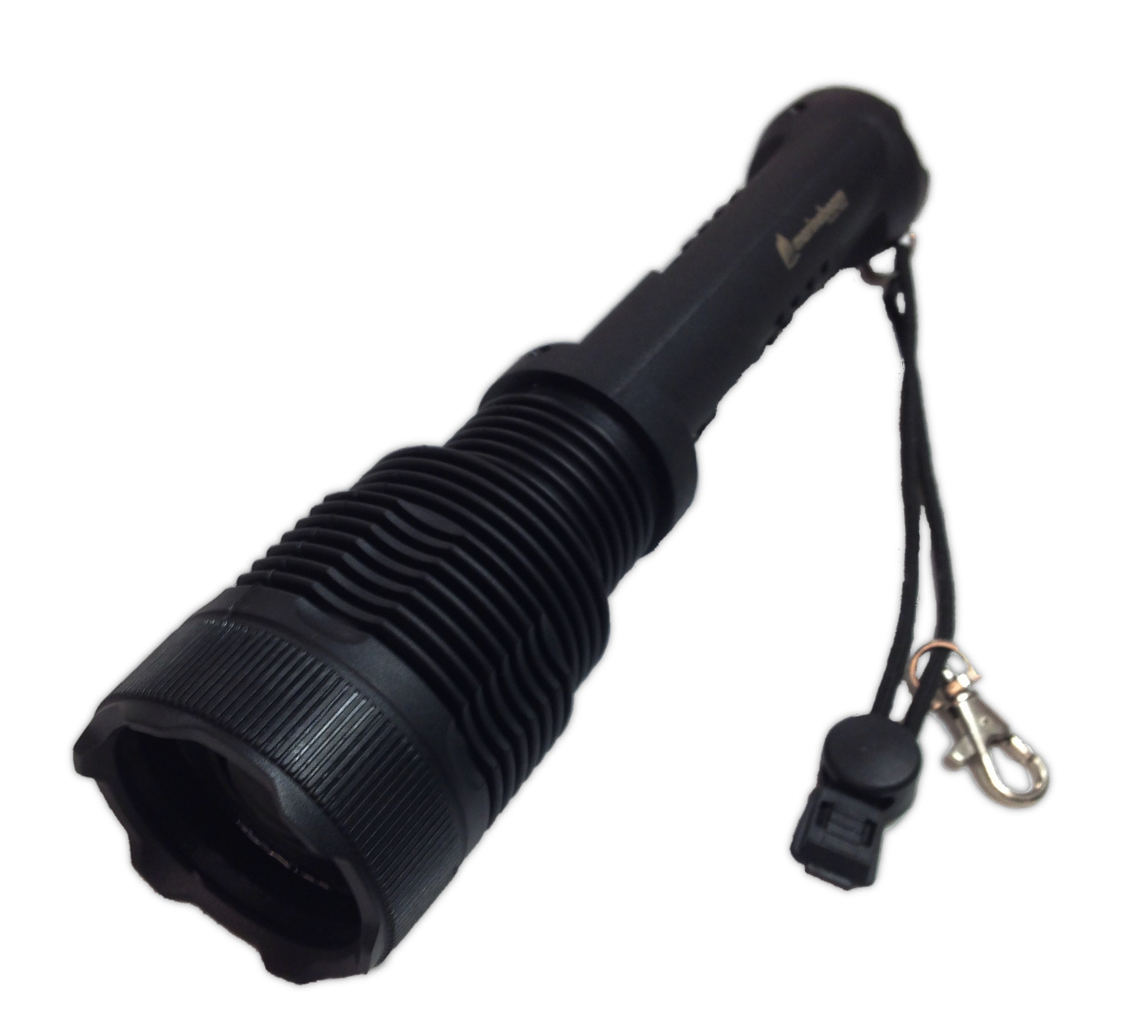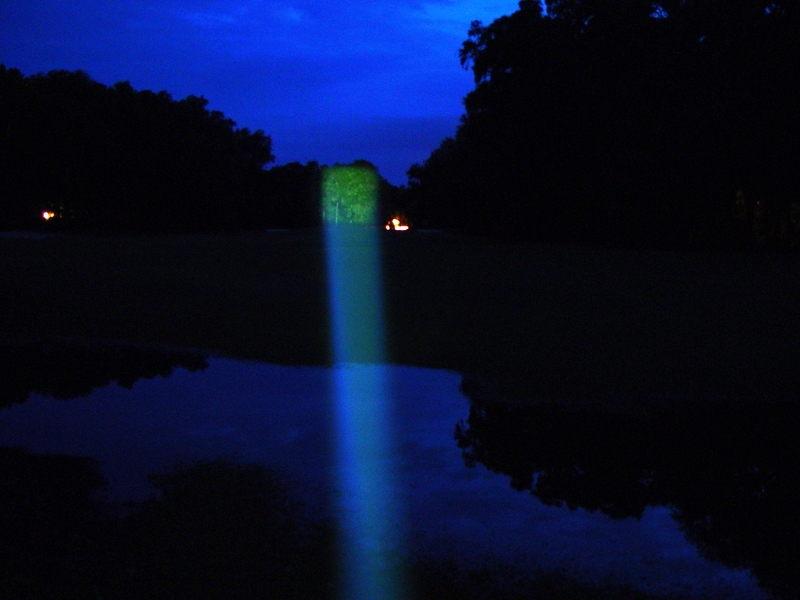
While our Long Range LED Illuminator flashlight has been taking the LED flashlight world by storm, and there is no other flashlight like it, regardless of size, we have had some recent feedback that some customers found it too big, and too heavy. Believe it or not, the customers have said that they didn't really believe all the reviews, and they never actually expected it to be so bright, or to have such exceptional battery life. They have asked for something a bit lighter, rechargeable, with a wrist lanyard.
So we teamed up with an existing LED flashlight manufacturer, and have added our patented RLT optics to create a wonderfully lightweight plastic rechargeable flashlight with 50,000 Candela output, and an FL1 beam distance or 447 Meters. While not the light-hammer that the classic version is, it can be much lighter, less expensive, and have a much smaller battery pack. Check out the website for more details.
We also get a lot of questions, and skeptics, regarding how RLT works. Basically, because of all the hype out there regarding flashlights, it is hard to imagine that such a simple idea had never been thought of or implemented until now. However, once you understand the basic limitation that all flashlights have, it is easier to understand how RLT solves it so easily. With the Long Range Illuminator, we are trying to create a flashlight with exceptional distance capabilities, and the RLT not only solves the limitations, but also improves the performance of the LED and the flashlight's collimating lens.

Imagine a wall with a 2" hole in the center of the wall. Now imagine the sun shining on one side of the wall. This represents every flashlight known to mankind. Basically we have a light source (the sun), and an aperture (the 2" hole). A flashlight is analogous to the sun and the hole in the wall. It has a light source (the bulb) and an aperture (the 2" lens, or bezel on the end of the flashlight).
It is quite intuitive to us that in the case of the sun, which is an exceptionally bright light source, that the amount of light that will make it to the other side of the wall is always based on the size of the hole. No matter how bright the source (or the sun, in this case), its light is always restricted by the size of that hole. You will always end up with two light beams, the portion that made it through the hole, and the portion that didn't. Obviously, the vast majority of the light the sun produced did not make it through the hole in our imaginary wall.
Most of us are also familiar with this concept when we think about cameras and lenses. The "faster" lenses, are always the bigger diameter lenses, and thus have better light-collection capabilities. Same with telescopes. In the case of the telescope very little of the light produced by the universe made it through the lens of the telescope to your eye. It is no different with a flashlight. No matter the lumens, no matter the wattage, no matter the CREE this, or the Samsung that, the restriction is always the size of that hole at the end of the flashlight. This "throughput" restriction will always limit the output of the flashlight.
So how does one solve this? You either make a bigger hole, or move the source closer to the hole . Or, maybe you could somehow convince the light source to create all of its light at the exact same angle required for all of it to get through the hole. With any of the above solutions you would be allowing the hole to accept more light. But, big apertures and big lenses are expensive and unwieldy, and even then, you are still blocking most of the light that the source is producing. You would, of course, consider using a reflector to try to reflect the wasted light and try to redirect it out through the hole to the target. Unfortunately, the reflector only redirects the wide-angle part of the beam that is not already radiating directly out of the hole in the end of the flashlight. So, half the beam is reflected and focused, but the other half is radiated straight out of the flashlight at its original, and diverging, angle. What this means is that half the beam is focused down-range, while the other half makes that big halo around the center hot spot. We are all familiar with that type of beam. Essentially two beams. The second beam, which represents more than 50% of the light, never makes it down range, and in the case of a spotlight is really completely wasted.
So if we use a lens, most of the light never hits the lens, just like most of the light from the sun never gets through the hole in the wall. If we use a reflector, we are only getting to use half of the beam for our spotlight. In both cases, there are essentially two beams, and we are wasting one of them entirely.
The Recycled Light Technology (RLT), works by capturing this second wasted beam completely, and reflects it directly back to the LED itself. When this light hits the LED chip, it re-excites the phosphors on the LED, which then re-emit more visible light. All of this recycled light leaves the RLT optic at the exact angle that is needed for this light to pass through the aperture unimpeded. Said another way, now all of the light from the LED is passing through the aperture, or in this case, the lens of the flashlight. So, while there are some inefficiencies in recycling the wasted light, the benefit comes from the fact there are no longer two beams, and all of the light emitted now makes it through the aperture (lens). In fact, using the RLT the "throughput" or gain through the lens is as much as 2.5X. Imagine that in the case of our sun example that we now had a sun which produced a large portion of its original rays at such an angle that they matched the size of the hole exactly. Even if we reduced the power of the sun, and kept the hole at a very small 2 inches, we would still get a lot more light through the hole than we would with the "normal" sun. This because the throughput through the hole is much greater.
There is also another benefit to the RLT, that while more technical, also benefits us for long range illumination. We can use our sun example again. We have all tortured ants with a magnifying lens. The sun became a death ray because the magnifying lens took the parallel rays from the sun and focused them into a tiny spot. Interestingly, if the example were reversed, and we could put a very intense light at that same focal point where we burned the ants, the light reaching the lens would be sent out in parallel rays (or be collimated). Collimated light has an infinite focal distance, so makes a perfect spot light. All of the rays are in parallel, and never converge or diverge, so, provided that we have the intensity required, they will absolutely get to their target. The key is that the light has to pass through that focal point for it to leave the lens in a collimated beam. Remember that with our Illuminator flashlight, all of the stray light from the second beam is collected by the RLT and redirected back to the LED chip. So, when the LED chip is re-excited, not only is the first beam emanating from the lens' focal point, but also the recycled light from the second beam is too. So we get perfect collimation of all the light. This is not possible with any other lens or reflector technology. While other flashlights can collimate their beam, they cannot collimate the second beam. So their second beam is always wasted.
The cool part is that the RLT technology can actually be applied to any LED flashlight, and the effect would be an immediate gain of up to 2.5X in brightness. We are now licensing this technology to some major players in the industry, so you will see more applications soon.

